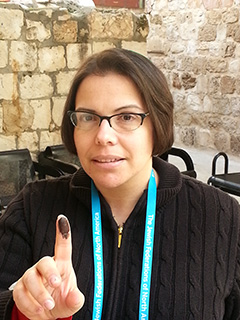From role model to criminal
Permanent link All Posts
When I finished rabbinical school, I moved to Chicago to be a second Rabbi-in-Residence at the Chicagoland Jewish High School.
In many ways, I was the female role model for the impressionable girls. Every morning I showed up for minyan, and put on my tallit and tefillin in order to daven with them. Softly, I encouraged more girls to take on this obligation. Some did, but most chose not to. It would be a lie to say that I did not feel deep admiration for the girls who chose to take on this obligation and stuck with it. Many hours were spent in conversation with female students about their place in the Jewish world. I loved the opportunity.
About three and a half years ago, I left Chicago to be the first Conservative pulpit rabbi in Queens, NY. Currently, only a few women in my congregation wear tallitot, but every twelve- or thirteen-year-old girl has purchased one for her bat mitzvah.
When I pray each morning, the tallit becomes an extension of my body. I don’t put on a tallit to demonstrate or as an act of rebellion. I wear a tallit because I am a Jew.
Monday, Feb. 11 this year was my final day of a week-long mission to Kiev and Israel with the Rabbinic Cabinet of the Jewish Federations of North America. It was coincidence that I was in Jerusalem for Rosh Chodesh Adar, and thus able to support and join Women of the Wall (WOTW) for minyan. This is a group of women who have been meeting at the Western Wall, on the first day of each Hebrew month, for 24 years, to celebrate with prayer, song, and Torah. My colleague, Rabbi Debra Cantor of Connecticut, along with many male rabbinic supporters, awoke early and flocked to the Old City. We had all heard of Women of the Wall, but had never davened with them before.
After a melodious Hallel, we left the Kotel en masse to Robinson’s Arch to begin the Torah service, as is the custom of WOTW. As soon as I exited the metal detector at the Kotel plaza, a police officer asked for my identity papers. I explained that I had a Canadian passport and then she asked for that. When I asked her why, I did not receive an answer.
Nine other women joined me at a satellite police station in the Old City. While some of the women had been detained before, there did not seem to be a clear reason as to why others were chosen. Throughout the morning, we were taken into an interrogation room, one at a time. I was informed that my two crimes were that I violated the regulations of holy places and that I behaved in a way that may violate public safety.
The experience was surreal, not scary. When I was in Chicago, I wore a tallit and was considered a role model, yet in Jerusalem I was considered criminal. It makes no sense.
After some time, we were told that we could be released, as long as we signed a surety document that stated we would not come to the Kotel for 15 days. I signed the document, and then at about noon, we were taken by police escort to a larger police station near the Jaffa Gate. Once there, we were fingerprinted and photographed. And then we were free to go.
Social media has been aflutter with positive comments about this experience. My own father contacted me from Canada to tell me that I was following in the footsteps of Heschel and Martin Luther King. More members of my synagogue have reached out to me to share the nachas they are feeling than I see on a given Shabbat morning.
That is all fine and dandy, but it does not lead to change. Last month, in response to growing pressure from Jews around the world, Prime Minister Netanyahu appointed Natan Sharansky the task of evaluating the situation at the Western Wall. Mr. Sharanksy, if you are reading, can you please do something soon. I am going back to Israel in the summer, and spending time in the company of Old City police officers does not fit into my schedule.
Rabbi Robyn Fryer Bodzin, who used to live in Lakeview, is the spiritual leader of Israel Center of Conservative Judaism in Queens, NY.



.jpg)



